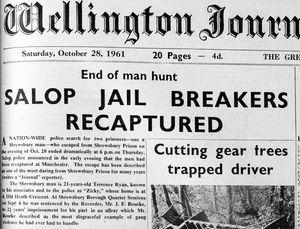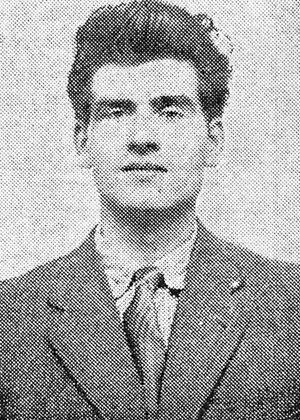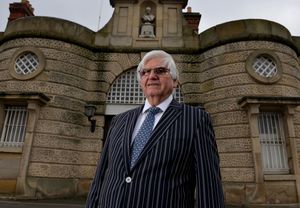Shrewsbury jailbreak which passed into Dana legend
A former bad boy and inmate of Shrewsbury’s Dana prison has finally told the story of his infamous escape. Toby Neal reports.
Feeling around the damp ground in the dark near the perimeter wall of Shrewsbury prison, Watt Groom found what he was looking for – a gun.
It was his contingency plan. For if he was not able to escape over the wall, he was going to go out through the front gates.
As he and two others stood on the brink of freedom, he told inmates watching the unfolding drama from their cell windows to send out anybody else who wanted to join them. But he got the slit-throat signal.
“Couldn’t believe it. They all bottled out. I shook my head. To think – this could have been Shrewsbury’s version of The Great Escape!” recalled Watt.

Using a rope with a makeshift cross hook fashioned out of metal bucket handles, he and another prisoner made a successful break for freedom from The Dana that night, Friday, October 20, 1961, sparking a nationwide manhunt which created headlines.
Now 82, the story of how this young man from a council house in the Black Country became a jailbreaker is told in a book called Over The Wall, by Barbara Kay, which is available on Amazon and draws on his memories and notes he wrote in his late 70s.
Billed as being based on a true story, containing fictional crimes and composite characters, the jailbreak of Walter Groom was a real event and is part of the legend of The Dana, which closed as a jail in March 2013.
The book was written because his two sons wanted to know more about his early life and that escape, about which Walter – Watt – spoke rarely until he was taken on a tour of the former jail as a surprise for his 81st birthday.

“He retraced his steps for a fascinated audience and later that day accepted an invitation to return and take part in a history day,” the book explains, adding that following the visit he felt the time was right to share his story.
His criminal career, mostly burglaries, started at the age of only 15 and the lure of easy money quickly saw this youngster from the Bilston area end up in Borstal.
A repeat offender, his first visit to The Dana was a four-year stretch in the late 1950s. When he walked out in August 1959 he said he was never going back but in September 1961 he was back inside for three years for a warehouse job.
“I’m 25 years old and Shrewsbury Prison is becoming my second home. With time off for good behaviour I’ll serve two years and it seems to stretch in front of me like an eternity,” he says in the book.

The idea of escaping came from a fellow inmate, a 21-year-old Shrewsbury man called Tonker in the book, but who in real life was known to both police and cons and Zicky.
He had been jailed for an affray which had left a police officer seriously injured, and he feared if the officer died he would hang. (He didn’t, and he wasn’t).
What followed was like a cons’ version of The Great Escape, with elaborate planning, lookouts, and distractions and ruses by inmates to put the ‘screws’ – prison officers – off the scent.
The method involved a manhole under coconut matting by the dartboard, which Watt discovered led to a shaft with an exit near the perimeter wall.

He tells how during the breakout he was sitting on top of the wall trying to haul up a third escapee when a commotion broke out in A wing.
“I hear the shout. ‘RE-COUNT.’ Cons are banging their tin mugs against the doors. A sort of warning.”
As the third escapee is being hauled up, the rope parts and he falls back heavily.
“’I can’t move... think it’s broke... you go.’ The screws are shouting our names. A Wing is in uproar as cons cheer and bang everything in their cells.”
Outside they land in the prison officers’ car park and head for the railway line.
“What’s with the gun Watt?” his accomplice asked.
“That was my contingency plan mate, if we couldn’t get over we were goin’ out the front gates.”
Six-day manhunt
With no need for the gun, and knowing it would mean big trouble if they were caught with it, he threw it into a hedge and they then set off down the tracks to Wellington, where they stole a Wolseley and drove to Bilston, before making their way to a safe house in Manchester. After a six-day manhunt they were arrested by armed police.
“Was it worth it? The excitement of the planning, the buzz as preparations got under way, a focus, a goal, adrenaline rushes, almost being caught and the tremendous effort of lifting that grid, anticipation as we stood on the brink, getting one over on the screws, and for what... for a few days of freedom.
“Inwardly I smile. Oh yes, it was worth it.”
The punishment was 100 days loss of remission and 28 days on bread and water at Strangeways, followed by punishment block at Durham.
It was not to be the last time Watt saw the inside of Shrewsbury jail.
His life was to change though in that cliched fashion, through marriage and fatherhood.
He and Barbara now live in Shropshire.
“Why have I chosen to tell my story? My past was kept hidden for years and I spent a long period of my life being ashamed,” he says in the book. “I was ashamed of my tattooed hands and ashamed of being in prison. With age comes realisation.
“It’s what I went through that makes me who I am. We get one life and live it how we see best for ourselves. Fate takes a hand but ultimately we make the decisions and, oh boy, did I make some bad ones. I’m not proud of the crimes I committed but having paid my debt I can hold my head up high. Think of me what you will. This is my story.”





